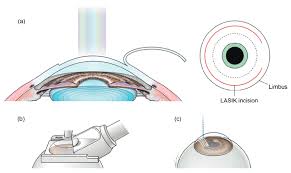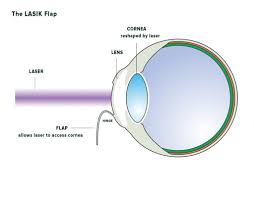Table of Contents
ToggleThe decision to undergo vision correction surgery is monumental, especially for the millions who have been tethered to glasses or contacts for most of their lives. Intriguing for its minimally invasive technique and rapid recovery, SMILE (Small Incision Lenticule Extraction) eye surgery has emerged as a cutting-edge procedure, proving to be a game-changer in the world of ophthalmology.
If you’re contemplating this procedure, you’re likely curious about one fundamental query – how soon after SMILE eye surgery can you expect to regain your vision?
Understanding the timeline of visual recovery post-SMILE is crucial to managing your expectations and preparing for life beyond corrective lenses. Here’s your comprehensive guide to when you can see clearly after your SMILE adventure begins.
The Initial Phase – Day of the Operation
You’ll walk into the eye care centre with visual aids like glasses or contacts and leave without them – a symbolic step into a future with better vision. However, clarity isn’t instantaneous due to the laser incisions and the natural healing process.
Following surgery, some may encounter hazy vision, akin to peering through a foggy window. This occurrence is entirely typical, mainly due to corneal swelling. Others may notice immediate vision enhancement.
- The First 24 Hours
Following your SMILE procedure, a crucial phase of rest and recovery awaits your eyes. Adhering to your surgeon and medical team’s guidance is paramount. Safeguard your eyes with shields to ward off accidental bumps or sensitivity to light. Improvement in vision is probable within hours post-surgery. But keep your expectations in check. - Days 2– A Glimpse at Steady Improvement
The day following, you may start to observe gradual improvements in your vision, allowing some patients to read the larger letters on an eye chart. Yet, reading smaller text could remain difficult, and the intensity of specific lights might feel overpowering. These indications suggest that your eyes are in the process of healing, and the swelling is gradually reducing. - Days 3-4– Clearer Skies Ahead
Within 3-4 days post-SMILE procedure, many recipients notice a marked enhancement in their vision. You may discover newfound independence in everyday tasks without the need for glasses – a significant milestone signifying progress. Typically, patients approach their pre-surgery vision during this period. At this juncture, your vision should be sufficiently improved to resume most of your regular activities with greater ease and comfort. Nonetheless, the healing process is ongoing, so it’s advisable to steer clear of strenuous activities that could strain or jeopardise the eyes. - Day 5-7– Enhanced Clarity and Fine-Tuning
By the end of the initial week and as you transition into the second week, your visual clarity should keep improving. You may observe a more precise and distinct focus as the cornea stabilises further. During this phase, your surgeon might conduct a follow-up examination to confirm that your eye is healing as anticipated. - Weeks 2-3 – Long-Term Adjustment
The two to three weeks post-SMILE window heralds a time of long-term visual adjustment. While the most significant changes are behind you, your eyes are still adapting. Fine-tuning of your vision is common, as is a slow and steady progression toward optimal visual quality. Patients may find that their night vision has improved, and the glare or halo symptoms have largely subsided. - Beyond 1 Month– The New Normal
At the one-month mark, many patients have reached their ‘new normal’ in terms of visual acuity. Your eyes’ healing progress is unique to you, and some individuals may continue to experience subtle changes or improvements beyond this point. Regular check-ups with your ophthalmologist will help ascertain the long-term success of your SMILE procedure and address any lingering visual concerns.
Realistic Timelines and Individual Variables
It’s paramount to understand that recovery timelines are not a one-size-fits-all scenario.
Personal factors such as age, prescription strength, and the body’s healing rate play a significant role in how quickly or slowly you’ll regain your vision after SMILE surgery. You may heal faster if you’re younger, have a milder refractive error, and follow post-operative care meticulously.
- The Psychology of the Recovery
More than just a physical process, the recovery from SMILE eye surgery is also psychological. The initial days of impaired vision can be frustrating for those expecting an overnight transformation. It’s important to be patient with your eyes and yourself. Preparing mentally for a realistic recovery timeline can help manage expectations and minimise any disappointment. Remember, the primary goal is not to see perfectly immediately after the procedure but to achieve clear and stable vision in the subsequent weeks and months. - Preparing for your Post-Operative Visit
Before your final visit, take note of how your vision has improved. Are you able to carry out your daily activities comfortably? Is there a notable difference in the clarity of your vision compared to when you were wearing corrective lenses? Do you experience any residual vision issues, such as glare or contrast sensitivity? These considerations will guide your conversation with your ophthalmologist and help establish whether additional treatments or adjustments are necessary.
So, the transition from glasses to clear vision after SMILE eye surgery is a nuanced and gradual process. While each patient’s journey to optimal visual acuity is unique, a well-informed and patient approach will ensure a successful outcome.
Your vision is a precious asset — allow the SMILE procedure to unfold at its own pace and revel in the joy of seeing the world with newfound clarity.













